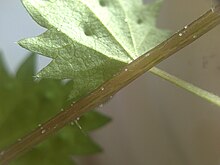Mallorca nettle
| Mallorca nettle | ||||||||||||
|---|---|---|---|---|---|---|---|---|---|---|---|---|
| Systematics | ||||||||||||
|
||||||||||||
| Scientific name | ||||||||||||
| Urtica bianorii | ||||||||||||
| ( Bones ) Paiva |
The Mallorca nettle ( Urtica bianorii (bone) Paiva ) is a species from the genus of nettles (Urtica). It only occurs in Mallorca .

description
The Mallorca nettle is a perennial herbaceous plant that forms a rhizome and reaches a size of 30 to 100 cm. The stem is dark green in color and covered with stinging hair. The opposite arranged leaves are divided into a petiole and a leaf blade. The petiole has a length of 2 to 5 cm and is lined with stinging hairs. The simple leaf blade is egg-shaped with a length of 2 to 3.5 cm, heart-shaped at the base, incised on the edge and covered with isolated stinging hairs on large bumps on the surface. At one node there are four free stipules that are lanceolate to ovate and have entire margins. The stipules of the lower nodes are toothed and partly petiolate.
The flowering period extends from May to August. The Mallorca nettle is single-sexed ( monoecious ). The protruding or hanging in the fruit ripe part of the inflorescences are 0.5 to 2 cm long and shorter than the stalk of the bract. The male flowers , arranged in clusters, contain four stamens . The sepals and petals are fused. The female flower has four bracts , which are blunt at the top and more or less hairy.
The bald, achena-like nut fruit is ellipsoidally flattened with a length of about 1 mm and a diameter of 0.7 to 0.9 mm; it is surrounded by the durable flower envelope.
The number of chromosomes is 2n = 24 or 26.
Occurrence
Urtica bianorii is endemic to the Serra de Tramuntana mountain range in the northwest of the island of Mallorca ( Balearic Islands , Spain ). It colonizes nutrient-rich soils on livestock stores, under rock overhangs and in ravines. It occurs at altitudes between 350 and 1000 meters.
The Mallorca nettle is a rare species and has been identified from six 10 × 10 km fields. It is classified as "vulnerable" in the Spanish Red List according to the hazard levels of the IUCN .
Systematics
The Mallorca-nettle was established in 1922 by the German-American botanist Hermann Knoche under the basionym Urtica atrovirens var. Bianorii Knoche firstdescribed and Brother Bianor (1859-1920), the collector of the type of document dedicated. In 1951, she was of Pio Font cross and Llorenç Garcias font as Urtica atrovirens subsp. bianorii Font Quer & Garcias Font upgraded to a subspecies, upgraded to a species by Jorge Américo Rodrigues Paiva in 1992 as Urtica bianorii (Bone) Paiva . This classification is followed by the Spanish-Portuguese standard flora, Flora Ibérica , the checklist of flora of Europe and the Mediterranean Euro + Med PlantBase and the German botanist Maximilian Weigend , who published work on the genus Urtica in the 2000s .
The similar Urtica atrovirens , which was found on the neighboring island of Menorca , differs from the Majorca nettle in that it has larger, longer-stalked leaves and longer, partial inflorescences that protrude above the petiole of the bract.
Individual evidence
- ↑ a b c d e f g h J. Paiva: Urtica. In: Santiago Castroviejo, Carlos Aedo, Santos Cirujano, Manuel Laínz, Pedro Montserrat, Ramón Morales, Félix Muñoz Garmendia, Carmen Navarro, Jorge Paiva, Carlos Soriano (eds.): Flora Ibérica. Plantas vasculares de la Península Ibérica e Islas Baleares, Vol. III. Plumbaginaceae (partim) - Capparaceae . Real Jardín Botánico, CSIC, Madrid 1993, ISBN 84-00-07375-4 , p. 264-266 ( floraiberica.es [PDF]).
- ↑ Peter Schönfelder, Ingrid Schönfelder: The new cosmos of the Mediterranean flora. Over 1600 species and 1600 photos (= KosmosNaturführer ). Franckh-Kosmos, Stuttgart 2008, ISBN 978-3-440-10742-3 .
- ↑ a b Anthos. Sistema de information about las plantas de España. Accessed on December 9, 2012 (enter the type in the search field “Búsquedas”).
- ↑ Juan Carlos Moreno Saiz (ed.): Lista roja de la flora vascular española. Actualización con los datos de la adenda 2010 al atlas y libro rojo de la flora vascular amenazada. Sociedad Española de Biología de la Conservación de las Plantas, Madrid 2011, p. 38, PDF file. ( Memento of the original from March 4, 2016 in the Internet Archive ) Info: The archive link was inserted automatically and has not yet been checked. Please check the original and archive link according to the instructions and then remove this notice.
- ^ Herman Knoche: Flora Balearica. Etude phytogéographique sur les Îles Baléares. Première partie. Catalog raisonné de toutes les plantes connues. Roumégous et Déhan, Montpellier 1922, p. 421 as a PDF file .
- ↑ Jorge Américo Rodrigues Paiva: Notas acerca de Urtica L. para la Flora Ibérica. In: Anales del Jardín Botánico de Madrid. Volume 50, No. 1, p. 130 PDF file .
- ^ Pertti Uotila: Urticaceae. Urtica bianorii In: Euro + Med Plantbase - the information resource for Euro-Mediterranean plant diversity. Berlin 2011.
- ↑ Maximilian Weigend: Urtica dioica subsp. cypria, with a re-evaluation of the U. dioica group (Urticaceae) in western Asia. In: Willdenowia. Volume 36, No. 2, pp. 811-822, doi: 10.3372 / wi.36.36212 .